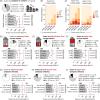Radon exposure is rising steadily within the modern North American residential environment, and is increasingly uniform across seasons
- PMID: 31796862
- PMCID: PMC6890734
- DOI: 10.1038/s41598-019-54891-8
Radon exposure is rising steadily within the modern North American residential environment, and is increasingly uniform across seasons
Abstract
Human-made buildings can artificially concentrate radioactive radon gas of geologic origin, exposing occupants to harmful alpha particle radiation emissions that damage DNA and increase lung cancer risk. We examined how North American residential radon exposure varies by modern environmental design, occupant behaviour and season. 11,727 residential buildings were radon-tested using multiple approaches coupled to geologic, geographic, architectural, seasonal and behavioural data with quality controls. Regional residences contained 108 Bq/m3 geometric mean radon (min < 15 Bq/m3; max 7,199 Bq/m3), with 17.8% ≥ 200 Bq/m3. Pairwise analysis reveals that short term radon tests, despite wide usage, display limited value for establishing dosimetry, with precision being strongly influenced by time of year. Regression analyses indicates that the modern North American Prairie residential environment displays exceptionally high and worsening radon exposure, with more recent construction year, greater square footage, fewer storeys, greater ceiling height, and reduced window opening behaviour all associated with increased radon. Remarkably, multiple test approaches reveal minimal winter-to-summer radon variation in almost half of properties, with the remainder having either higher winter or higher summer radon. This challenges the utility of seasonal correction values for establishing dosimetry in risk estimations, and suggests that radon-attributable cancers are being underestimated.
Conflict of interest statement
The authors declare NO competing (financial or non-financial) interests or other conflicts of any kind. The funders of the study had no role in study design, data collection, analysis, interpretation, or preparing the study manuscript or figures.
Figures







References
-
- World Health Organization. WHO handbook on indoor radon: a public health perspective, xiv, 94 p. (World Health Organization, Geneva, Switzerland, 2009). - PubMed
-
- Pearson, D. D., Anikin, A. & Goodarzi A. A. Environmental sources of ionizing radiation and their health consequences. in Genome Stability (eds. I, K. & O, K.) 712 (Elsevier, 2016).
Publication types
Grants and funding
LinkOut - more resources
Full Text Sources

